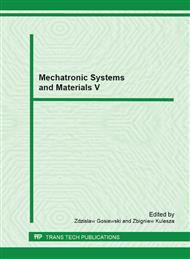p.188
p.194
p.200
p.205
p.209
p.217
p.223
p.229
p.235
Tribological Characteristics of Anodic Oxide Coat (AOC) Modified - Sealed up the Polymer
Abstract:
The paper represents the results of investigations conducted on the tribological test for the conditions of the friction of technically dry. Analysis stereological counter-specimen was subjected from AOC and AOC modified sealed up the polymers that is composites coats. Polymerization occurred at a temperature below the recrystallization temperature of the alloy EN AW 5251. The values of the coefficient of the friction, and the results of investigations AFM (atomic force microscopy) and the parameters of the roughness were compared. The tribological properties composites are investigated by using the pin-on-disk type rotational wear tester T-01 M. This paper shows models 3D of the AOC modified polymer and the mechanism of wearing. Tribological measurements show reduced wear and friction of the composite coatings as compared with the pure anodic oxide
Info:
Periodical:
Pages:
209-214
Citation:
Online since:
March 2013
Authors:
Keywords:
Price:
Сopyright:
© 2013 Trans Tech Publications Ltd. All Rights Reserved
Share:
Citation:


